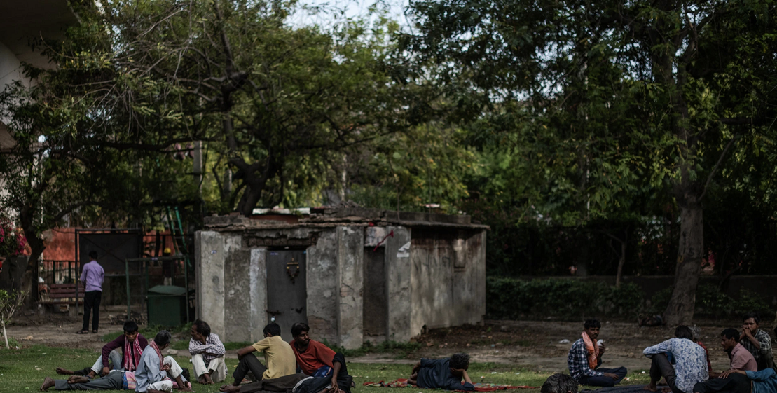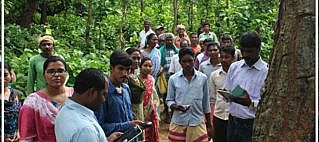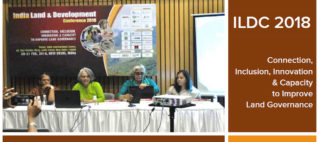“ Can India’s Rural Property Card be an opportunity to expedite Post-Covid Rural Revival? "
About the authors
Mr. Pranab R. Choudhury is the Founder-Coordinator of NRMC Centre for Land Governance|
Mr. S. Chockalingam the Settlement Commissioner, Government of Maharashtra.
Opinions are personal
This article was earlier published in LandPortal Foundation
COVID-19 refugees rushing back home, rural population in India, as elsewhere in the developing countries and emerging economies, is fast swelling up and suddenly it has become the new sink of labour, with cities and new-economies emptied up their workers. Corona lockdown has witnessed one of the biggest inland migrations(link is external) in India’s modern history. During March 19-30, 2020, India’s rural population has increased(link is external) by 7 percent while cities lost between 4 percent and 11 percent. A second wave(link is external) started in early May, with facilitation by Central and state Governments, expects to populate rural India with about another 10 million informal workers.
Out of the total 465 million workers in India, around 90 percent are informal workers(link is external), who lack regular incomes. Rural farm workers or agriculture laborer represent, another half of the informal workforce. Together with small farmers including tenants in rural India and urban workforce, they form almost half of India’s population. This strong army of food producers and nation builders are the most affected by COVID19 crisis, and now largely converged in Rural India. Post-Covid19 rehabilitation and growth imperatives lie in triggering rural revival and more particularly enabling these informal workers to rebuild the economy, by infusing adequate and dignified finance in their hand.
Ironically, for these informal workers and farmers, informality around land tenure is also an inevitable reality. The informality accompanies them as they live in urban homes-slums, when they cultivate farm lands on lease and forage wild foods and wild biomass from the government/public lands (de facto common lands), even moving with them to their village homes, where they have been living for generations. It is the last informality around homestead lands and housing property, remain least visible, yet a grim reality in India. And addressing it at a time when many hopes are lost, provides a rare opportunity to trigger an inclusive rural revival.
Unlike informality or insecure tenancy over farmlands, urban slums, forest and commons, informality over homestead land and property rights, is less configured in India’s land administration and development discourses. But, in the provinces of India, village inhabited sites or abadi land mostly are un-surveyed lacking any land records or the records where created, remain un-updated for decades. That, evidently and ironically, makes most of the India’s rural households’ land and property rights over the land they live and build houses, informal, which can be interpreted financially as a dead capital and legally a source of conflict.
Indian households hold 77 percent share of their wealth in land and property, more than China (62 percent) and US (44 percent) as per a RBI Report in 2017, but with poor capitalisation. Absence of a legally robust property documents make these household land assets ‘dead capital’, as per economist, Hernando de Soto. This property converted to financial asset, can trigger the revival of rural economy post-Covid, adding dignified as well as substantive finance in the hands of poor, informal workers, to kickstart productive activities, key to revival of rural economy.
That just 1.98 percent of India’s rural population (Census, 2011) are homeless in comparison to 38 percent landless rural households (SECC, 2011), make the focus on rural property a more inclusive strategy. Housing asset financialization can generate capitals, which the converging labour in rural India, desperately require to rebuild their livelihoods and nation.
In this context, launching of Central Sector scheme, “SVAMITVA – Survey of Villages And Mapping With Improvised Technology in Village Areas” in 24th April 2020, amidst COVID19 lockdown, ignites hope for rural revival, post-Covid. This scheme, aims to generate property cards, to facilitate monetization of rural residential assets for credit and other financial services. Led by Ministry of Panchayati Raj (Local Self Governance), it aims at surveying the rural inhabited land parcels using Drone technology and involving Gram Panchayats to cover India’s 0.662 million villages in four years.
With all seemingly right ingredients and right intentions, to set right a chronic problems of rural property records at scale, its guidelines demonstrate a unique combination of partnerships, participation, democratization and technology innovation to implement and impact rural property rights in India.
The idea for this scheme has come from a Maharashtra pilot, where Revenue Department piloted a survey in conjunction with Survey of India to help the Rural Development Department build a GIS based Property (Tax) Register. State Government has since upscaled the pilot to cover all un-surveyed villages and generate 12.5 million property cards.
By involving Gram Panchayat (Village Municipalty) in the survey process and subsequent property tax collection, the scheme expands the space of land administration, ensure democratized decentralization of land survey and aims to improve the tax collection of the local governments, critical steps towards devolution of power aimed in 73rd amendment of Constitution of India, back in 1990s.
The survey aims to address two rural property problems that different Indian states face, thanks to Colonial land administration legacy. For first group of the states, where village house sites are surveyed earlier about few decades back, their land records are now redundant. India’s flagship DILRMP (Digital India Land Records Modernization Program), initiated with the World Bank support, has been able to computerize most of the existing land records and substantially digitize old cadastral maps; however limited resurvey (12 % of villages) leave the house site land records largely non-updated. This has been the major reason behind two-thirds of civil court cases in India.
In other group of states, ABADI (inhabited) area of villages are not surveyed till date. With the colonial administration’s focus on surveying farm lands, which was the main source of revenue, village housing sites or inhabited areas used to be left un-surveyed in detail, often showing tham just as one parcel. States/regions carved out of Bombay and Madras Presidency as well as from Punjab province, inherits this legacy. While some of the villages were surveyed and settled subsequently for different reasons, , still a majority of them continue as such viz. Lal Dora areas in Delhi, Haryana and Punjab and Gaothan lands in Maharashtra, Gujarat etc.
Svamitva, aims to provide an integrated property validation solution addressing both kind of the problems and issuing property cards to the property owners in all states. Scheme’s potential, however, can be expanded by issuing property cards for also for new rights viz. homestead land grants and forest rights (house sites), that are now recognized over Government lands, outside, sometime little far of the village habitation site. While recognizing housing rights over individual parcels, it is also essential to leave some land within the residential area, to accommodate needs for future potential public purposes and also for housing future generations.
That land records in most states lack a gender column need to be taken note of and gender concerns be integrated in the property records. All names of family members, including that of women, must be recorded. Property cards should have a gender column to ensure easy monitoring and generation of gender-disaggregated data. Survey process should also ensure proactive inclusion of dalits, windows and other such households, who lacks visibility and voice, and known to be marginalized in survey processes.
Most states lack survey manpower for which there will be now a massive need. Provisions of private or licensed surveyors, as permitted in new survey laws in many states must be tapped; others lacking it can amend their laws, to remuneratively engage rural youth. Their capacity can be built in partnerships with relevant stakeholders using the financial resources of the National Skill Mission. With potential generation of at least one million of rural employment @ 1-2 surveyor for a village, this can boost post-Covid economy. These surveyors, can be very useful for subsequent updating of property records, which would be an inevitable imperative as rural economy grow and property are transacted and subdivided increasingly.
SVAMITVA Scheme provisions envisage property records to be managed by Land Revenue Department while Property tax record by Gram Panchayats. Digitally linking them will be critical to improve coordination, sync changes and add efficiency. It would help to better relate the holders in land records with the occupants in tax record.
Panchayat is involved across the steps of sensitization, delineation, survey, legal notification, joint verification and also initially in dispute resolution. Adequate capacity and accountability building will be critical to ensure they follow democratic norms, not tyranny, as power often lead to, land being an entity not only for identity and entitlement, but also one which wields power.
While drones have demonstrated success in similar recent pilots of Survey of India with some states, they also raise expectations, has limitation in terms of flying regulations under new Drone Policy. Therefore, space for following Fit for Purpose land administration approaches including use of other better adaptive digital tools fitting to the diverse rural and biophysical contexts must be kept open.
The scheme has potential to augment low level of tax collections, by rural local governments which is only 5 percent as per Economic Survey 2017-18. It paves the way for clear determination of property tax and therefore can help Gram Panchayats better manage their finance and invest in improving better civic amenities.
In this Central Sector Scheme, Government of India contributes 10 percent while expecting the states to the mobilize the rest of the finances, which is a very high order of expectation, considering the fiscal balance of most states, particularly at the time of COVID crisis, when revenue receipt has nosedived.
Maharashtra pilot shows potential willingness of households to pay for the property card @ INR 2000, to make the scheme revenue neutral. Therefore, the states may need only some seed money as advance, which can potentially be mobilized by state and centre from existing sources temporarily. Maharashtra experiment estimates invest around INR 1000 million upfront as seed money to effectively take the scheme to a logical end for an average size state. In its absence, only images would be taken by the Survey of India, which costs Federal Government’s contribution only take care of; property records would hardly be delivered.
Available Financial Commission grants for Panchayats from Federal kitty with its flexible spending option can be a potential source to tap. With many villages with higher tribal or dalit population, coming under usually well-funded Tribal Sub Plan and Special Component Plans, such financial reserves can be checked to introduce free/subsidized surveying options for the marginal tribal and dalit communities. Rural financing options available under India’s National Bank for Agriculture Rural Development (NABARD) can also be a potential financing mechanism as a long-term loan for the State Governments, a practice that is already being used for other rural development works.
India’s Prime Minister has declared INR 2 trillion package for post-Covid economic revival, where ‘land has been hinted as one of the priorities. Coming exactly a fortnight after launching of SVAMITVA, this may be the right finance mechanism for right operationalization of the scheme at a right time to set right the long pending housing land rights for a billions of the Indians.
Secure land tenure is known to alleviate poverty, ensure food security, help adaptation to climate change and is identified with clear, transparent and updated land and property records. Despite this hegemonic discourse, both markets and states have failed to deliver secure land and property rights in many countries including India.
Svamitva, in this backdrop, seems a bold reformistic step, launched at a time, when it is important to supplement post-Covid-revival. It can be a very productive investment with inclusion implications for the millions of informal poor workers, now converged in rural India. It merits attention and political buy in by states, while also needing innovative financial mechanism, simple legal amendments, local institutional adaptations and strategic capacity building of the stakeholders. Land is too complex a subject to handle and the space expanded by Svamitva by bringing in a local democratic actor, throw out an opportunity, the post-covid strategist must not miss.




